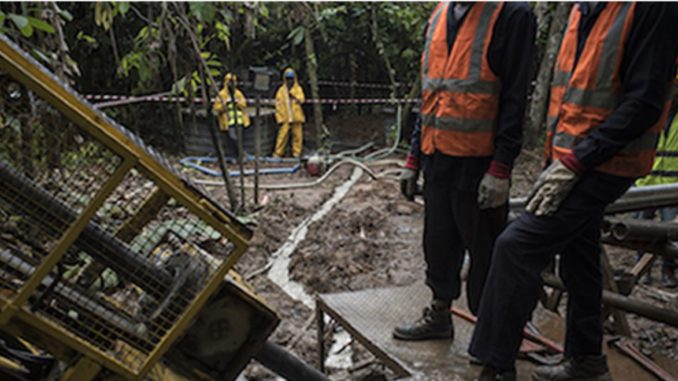
There is a connection between those engaged in illegal mining activities in Zamfara State and marauding bandits who have become thorns in the flesh of the ordinary folk in the rural areas of the state. Collectively they pose a serious threat to national stability and development.
After more than 5,000 people had lost their lives to the criminals in five years, Federal Government suddenly woke up to ban illegal mining in the North, a crime ignored for several decades because of the privileged persons involved.
Although Zamfara gold should provide development opportunities, renewed interest in the solid mineral represents a real threat to stability in the North-West. The availability of gold appears to nurture deep-seated resentment among local communities and contributing to border tensions with neighbouring tribes.
The situation has given rise to fears that the presence of gold reserves in commercial quantity in the region would exacerbate deep-rooted conflict dynamics.
An upsurge in fighting since the start of 2010, including the emergence of bandits, has further complicated the situation. Conflict gold remains a major obstacle to peace and a driver of the black market economy in Zamfara. It provides a significant source of income to armed actors from the North-West, who kill and sexually abuse civilians with impunity, while trading gold for weapons and ammunition.
Politicians and other powerful individuals, it is alleged, are fuelling the ongoing and destructive gold mine wars, just as it happened in Liberia, Sierra Leone and some other African countries. The bandits raze markets and homes and kill villagers indiscriminately.
Although Zamfara is rich in gold, mining activities in the state are unstructured, largely informal and illegal. Artisans, most of whom are unskilled, are in charge of the extraction, purification and commercialisation of the solid mineral on a small scale.
The fact that traditional rulers in the state accused the Nigeria Air Force pilots of missing the actual culprits and hitting “innocent villagers” in misdirected airstrikes, calls for more stakeholders engagement on the subject.
“Reports from Mutu in Gusau and Tsafe local government areas, Tangaram in Anka local government and Dumburum in Zurmi local area, among others, are that the areas shelled were not the actual hideouts of the bandits and the victims were innocent civilians. We call on the federal government to come to the aid of the state, especially the people in our rural communities who are in very dire need of life supporting material. Thousands have left their homes, and farming and all economic activities have been put to standstill in most rural areas,” the emirs were quoted as saying.
The bandits also rustle livestock across villages and communities in Zamfara. Hundreds of cows, goats and birds have been forcefully taken from homes by rampaging bandits. From Ajia and Wonaka in Birnin Magaji local government, to Kayayi village in Shinkafi local government, from Yan Taskuwa to Kucheri, from Tungar Kolo to all the Kara markets in Zamfara, the criminals have left sorrow, tears and blood in their wake.
The spate of killings in Zamfara has also prevented farmers from going about their legitimate businesses. As a consequence, food has become scarce in the state. The gold mine wars have spread to Kaduna and other neighbouring states. The military appears to have no control over the widespread war in which cattle rustlers, armed robbers, kidnappers and bandits are fully involved.
The mass lead poisoning from mining activities in Zamfara State in Nigeria, which was discovered in March 2010, continues to affect villagers in three Local Government Areas, namely, Anka, Bukkuyum and Maru. Incidentally, the mining communities are also not immune to the activities of these bandits.
On November 8, 2016, no fewer than 45 illegal gold miners were killed in Bindim Village, in Maru Local Government Area of the state. According to a survivor of the attack, which took place in the afternoon, the bandits, numbering about 50, cordoned off the entire area before ransacking the mines, demanding gold and other precious stones from the miners. There is nothing to suggest that the culprits were ever arrested, despite the pledge made by the police.
Gold is found in the Maru, Anka, Malele, Tsohon Birnin Gwari-Kwaga, Gurmana, Bin Yaurin Okolom-Dogon Daji and Iperindo areas of Zamfara State.
A major outbreak of lead poisoning in children, related to the processing of lead-rich ore for the extraction of gold, was reported in 2010. The Zamfara State Ministry of Health was informed by Medecins Sans Frontieres of the increasing rate of infant mortality and illness in Bukkuyum and Anka Local Government Areas of the state. At the request of the Nigerian Federal Ministry of Health, the United States Centers for Disease Control deployed a response team to assist in investigating this outbreak. At the same time, the Blacksmith Institute sent a team from Terra Graphics Environmental Engineering Inc to conduct an environmental assessment. These teams worked with the national and state authorities, MSF, and the country office of the World Health Organisation.
The investigations confirmed severe lead poisoning in more than 100 children in the villages of Dareta and Yargalma, with a mean blood lead concentration of 119 g/dL (levels as low as 10 g/dL are associated with impaired neurological development in young children). Moreover, lead concentrations in soil of 100,000 ppm were found in and around habitations in the villages (the limit for residential areas applied in the USA and France is 400 ppm).
The team, working with the Zamfara State Ministry of Health, confirmed a high degree of environmental lead contamination from the same cause in five additional villages, namely, Tungar-dadj, Abare, Duza, Sunke and Tungar-guru.
Inwalomhe Donald contributed this piece from Sokoto, Sokoto State
END

Be the first to comment